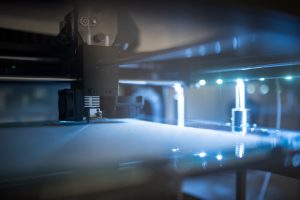The ever-expanding world of three-dimensional printing has made its way into the field of radiology, and is already showing huge potential in everything from training medical students to assisting doctors with surgical planning and preparedness.

The use of 3D printing to make life-like anatomic forms from medical images has brought medical imaging into the tangible realm by creating physical representations of a patient’s anatomy. By using CT or MRI images, a desired subset of the patient’s anatomy can be printed into a handheld form with dimensions equivalent to the real thing. This may seem redundant when considering the 3D images already created by post-processing software, but value has been demonstrated in the creation of physical forms, particularly with surgical simulation, management and planning.
This new technology has been found useful for technically challenging interventions, where a trial run in a patient with complex anatomy would previously not have been possible. One case report described a patient with complex aortic arch anatomy after aortic coarctation repair that required stent placement. In this case, a 3D printed model of the patient’s thoracic aorta was created from MR images, and a simulated case was then performed under fluoroscopy using the 3D printed model. This gave the interventionalists a practice run, so when they placed the stent in the actual patient, they were already familiar with the proper stent size and any nuances to stent deployment within the hypolastic aortic arch—information typically only gained on the spot, during the course of the procedure. The authors reported the simulation to be useful and found excellent anatomic agreement between the 3D printed model and the angiographic images used during the procedure.
Another example was reported in a study that evaluated the treatment of slipped capital femoral epiphysis in children. CT scans were used to create patient specific models of the hip deformity, which were then evaluated by the surgeon prior to the procedure. The authors found that surgical and fluoroscopic times were decreased in the group that had the 3D models available before surgery. Similar to the aortic case, being able to fully visualize the patient’s anatomy before surgery clearly can improve technical components of the procedure.
Simulation in medicine is a growing sector. Although not a traditional part of medical education, medical schools and residency programs are increasingly using simulation of patient care to better prepare trainees, particularly for high-risk and stressful situations, such as a code. The days of “see one, do one, teach one” are appropriately becoming a thing of the past. Even after medical training, physician participation in patient procedure simulation can be beneficial, as demonstrated in the studies above. Diagnostic radiology and 3D printing play an important role in simulation by serving as a conduit for bringing the intangibilities of medical images back to life, creating a much more realistic simulation scenario.
This is the very beginning of the merging of these two ever-evolving fields, and we can’t yet know all the possibilities and potential of 3D printing in diagnostic radiology—though we can be sure this is just the beginning. In the future, radiologists could potentially provide a 3D model of pertinent anatomy along with the traditional interpretation of images and report in every patient’s chart.
1 Valverde, I., Gomez, G., Coserria, J. F., Suarez‐Mejias, C., Uribe, S., Sotelo, J., … & Gomez‐Cia, T. (2015). 3D printed models for planning endovascular stenting in transverse aortic arch hypoplasia. Catheterization and Cardiovascular Interventions, 85(6), 1006-1012.
2 Cherkasskiy, L., Caffrey, J. P., Szewczyk, A. F., Cory, E., Bomar, J. D., Farnsworth, C. L.,… & Upasani, V. V. (2017). Patient-specific 3D models aid planning for triplane proximal femoral osteotomy in slipped capital femoral epiphysis. Journal of Children' Orthopaedics, 11(2), 147-153.